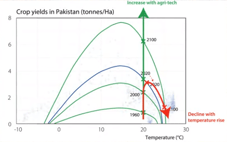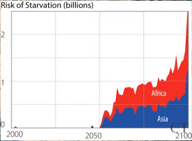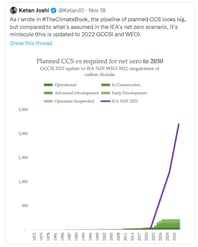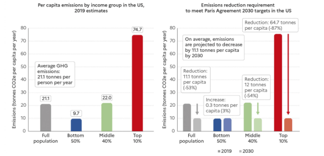
The 1 Percent Are Many Times Worse Than the Rainforest Wreckers
We cannot allow plutocrat-pampering pundits within elite media to derail us from what should be the most important task of our collective lives: to curb planet-warming carbon emissions.
Elite media, such as the New York Times, loves to parade passionate rhetoric about protecting rainforests. Consider the coverage around the recent presidential runoff election in Brazil. A melodramatic Oct. 27 New York Times video declared that the results would determine our “chances of surviving.” The accompanying text explained: “Whoever wins will inherit control over more than half of the Amazon rainforest and, by extension, will determine the conditions for future life on Earth.” The author asserted that “human civilization literally depends on” how Brazilians vote. Jair Bolsonaro could destroy the basis of life on Earth, meaning that ”there is only one right choice,” otherwise “we’re all cooked.”
Just a few days later, The Washington Post more soberly declared that “the significance of the Amazon … in the fight against climate change can hardly be overstated.” Deforestation has shrunk the rainforest by about 17 percent, and “scientists warn that the lungs of the planet, vital to slowing global warming, are approaching a tipping point.”
Such “save the rainforest” rhetoric may move our hearts, but it is carefully calibrated to conveniently let climate-concerned audiences off the hook. Saving the rainforest is a feel-good proposition coming from the same outlets whose pundits exhibit what I’ll call a repugnant optimism and recreational righteousness about our responsibility to address climate change.
While we rejoice that the result went the right way (leftist Lula da Silva defeated Bolsonaro), we’d be wise to ponder what such passion-stirring rainforest rhetoric neglects. Beyond the biodiversity blessings and “sky river” benefits, how much carbon does the Amazon absorb? How do the “lungs of the planet” stack up against capitalism’s smokestacks?
Not so well, it turns out. And not nearly what that high-stakes elite media rhetoric suggests.
The tricky truth is that the climate crisis is primarily propelled by consumption and, as we’ll see, driven to a disproportionate extent by the consumption of people who read elite media.
The fastest (and therefore most prudent) path to protecting “the basis of life on Earth” doesn’t run mainly through the Amazon (however important it is to save the rainforest). It involves ensuring that materially-cosseted elites stop hogging more of the planet’s resources than is compatible with a thriving human population and biosphere. The science is clear: consumption cuts are required. Arithmetic and justice demand what could be called “elite austerity”—constraints on lifestyles of the world’s wealthy. But this is something that elite media simply isn’t going to tell you.

The Amazon’s Lungs Versus the 1 Percent’s Dump-o-rama
There are a range of relevant estimates as to how much carbon the Amazon can absorb. The Washington Post reported that the Amazon’s annual carbon sink rate matches Germany’s emissions, which were “762 million tonnes of carbon dioxide” in 2021. Dr. Carlos Nobre, a leading expert at the University of São Paulo’s Institute for Advanced Studies, puts the figure at 1 to 1.2 billion tons per year. Meanwhile, global economic activity dumped a total of 41 billion tons of carbon dioxide equivalent in 2021—dwarfing the Amazon’s quickly dwindling carbon sink capacity between 34 and 54 times over. The “lungs of the planet” can sequester, at best, just under three percent of current annual carbon emissions worldwide.
Now let’s add the crucial context of how carbon generated by personal consumption varies by income (a near-taboo for much elite-feelings-focused media). The world’s top 1 percent by income generate an astonishing 17 percent of global carbon, while the global top 10 percent generates about half of the total. Running those numbers suggests that annually offsetting the emissions of the top 1 percent would require between 6 and 9 Amazons; for the top 10 percent, between 16 and 26 Amazons.1
Now consider the impacts of aggregate deforestation in recent decades. The 17 percent of the Amazon already destroyed is equivalent to emitting 18 billion tons of long-stored carbon. That’s less than a single year of the global top 10 percent’s emissions. Wrecking the rest of the entire rainforest would release between 90 and 1202billion tons of carbon. That’s only around ten years of our carbon.
It’s likely no accident that most of the audience of the outlets quoted above occupy the high-carbon-hog categories ($53,000 per year puts you in the global top 10 percent, U.S. college graduates have a median income higher than that, and the majority of New York Times readers are college graduates). Perhaps without audience-pampering, feel-good filters, these outlets might report passionately on how the resource-intensive lives of their readers are 6 to 26 times more of an obstacle to our “chances of surviving” than mustache-twirling climate villains like Bolsanaro. To ignore these sorts of concrete consumption trade-offs is perhaps the defining charismatic mega-folly of the rich-world’s “save the rainforest” set.
Obviously, there are many non-carbon related reasons (e.g., biodiversity, continental rainfall patterns, indigenous rights) to protect every square inch of wilderness that we can. And while in the future we should be able to substitute lower, or, preferably, carbon-free consumption alternatives, most of those options won’t be widely available for many years (like items made from zero-carbon steel or carbon-free concrete). Additionally, these fabulous optimism-enabling, tech-and-markets options do nothing to reduce emissions that are happening now and before 2030.
We’re already nearly a third of the way through what has been called the “decisive decade” during which we would need to make a 50 percent emissions reduction by 2030 to stay on track for the Paris Agreement goal of trying to limit warming. And bodies such as the UN Environmental Program, the IPCC, and the World Inequality Lab all have concluded that rapid cuts in elite consumption are necessary. But that isn’t what elite media is telling its audiences. As Lee Zimmerman summed up in his review of media and politician climate coverage for Current Affairs last year, “our climate discourse is gradually normalizing an atrocity” by promoting corporate friendly buzzwords and “fabulistic technophilia” around net zero and negative emissions technologies. (As I wrote earlier this year, the Davos elite’s “net zero” plans are “an intricately choreographed ballet of baloney.” They just don’t add up.)

Distracting Us from Emissions Cuts
“Save the rainforest” is just one narrative deployed to distract us from the unavoidable need for elite consumption cuts. Others include talk of carbon capture and store (CCS) or negative emission technologies. The problem here is that the real-world limits of such strategies often get glossed over. As the multi-Amazon metrics we just reviewed should make crystal clear, there are hard limits to natural or biomass-based carbon mitigation (biomass is basically vegetation that can absorb carbon). Besides, we “can’t expand our use of biomass [for carbon mitigation] because we’ll need it for food,” writes Julian Allwood, Professor of Engineering at University of Cambridge. His integrated big-picture analysis finds that the key climate threat is not “sea-level rise, higher temperatures, extreme weather, or drought, although they all matter. The real problem is food.” Crop yields will fall quickly as temperature rises. Here are Allwood’s charts.


If we fail to quickly curb global carbon, many “equatorial countries will not be able to grow the food that they need, or afford to buy it.” This raises the ghastly specter that “around a billion people will starve to death” this century. Allwood fears that would make ”a world war over food” inevitable. As I noted recently in these pages, the world’s poor are already experiencing severe food stress. (The evil capitalist logic of commodities markets allows some of the worst of the greedocracy’s ghouls to profit by gambling on food prices, a game whereby the world’s richest investors gain by taking calories out of the mouths of the poorest children on the planet. The result is vast and avoidable death and suffering.)
On the tech mitigation side, Allwood provides an all too rare techno-realist voice. He’s not remotely tech averse, nor a pre-committed rosy-eyed techno-optimist. Rather, he contributes a robustly-built engineering realism: he knows that scaling energy infrastructure takes decades. And since our total current global technological “capacity for carbon storage is just 0.08 percent of global emissions,” it should not be considered as part of “serious climate policy.”
Here’s a chart that corroborates Allwood’s skepticism. It shows actual carbon capture projects versus what’s projected by a typical techno-optimistic report (it was recently tweeted by Ketan Joshi, one of the hundred contributors to Greta Thunberg’s project called The Climate Book, to be published in the U.S. in February 2023). The image is from an International Energy Authority report and shows, with the purple line, a projected “plan” (closer to fantasy) to reach, by 2032, over 2 billion tons of CCS/Carbon Capture and Storage capacity, a fiftyfold increase from today’s 40 million tons capacity. The GCCSI 2022 refers to the Global CCS Institute 2022 status report, from which the green lines are drawn and from which the estimate of 40 million tons current capacity is drawn.3 That purple line, therefore, represents the “ludicrous technological assumptions in mainstream climate modeling,” according to the spot-on assessment of ecological activist Andrew Ahern.

Allwood strongly recommends that the prudent approach is to assume that we “are unlikely to have any significant negative emissions tech” scaled up by 2050. Hence his work focuses on what a “Real Zero” carbon future looks like.
No scientifically or mathematically or morally coherent climate plan can ignore the fact that people living at a Global North middle class standard or higher have, in terms of combined carbon impact, a worse effect than that of notorious climate villain Bolsonaro. A global 1-percenter imposes 1,800 times the carbon burden of a citizen of Burundi (110 vs. 0.06 tons per capita per year). Collectively, 1-percenters cause 11 times the emissions of notorious climate villain ExxonMobil.4
Ironically, this severe top-skew brings a potentially life-saving silver lining: lifestyle changes by a tiny elite can deliver huge gains (and leapfrog delays and veto-points that typically plague political and systems changes, to have large near-instant impacts). For instance, each 1 percent cut in personal carbon from Americans in the global 1 percent is akin to nixing 17 coal plant units.5That same “1 percent cut by the 1 percent” is equivalent to taking almost 8 million cars6 off the road. For context, cutting out one premium long haul return flight, say New York to Los Angeles, would achieve that “1 percent cut by the 1 percent.”7
That all prudent climate paths require aggregate consumption cuts should not really be news. Again, the relevant authorities have long said so (IPCC, WIL, and UNEP reports describe what consumption cuts would look like).
Here are World Inequality Lab’s charts for U.S. cuts needed by 2030 (they use an equalized emissions scenario where every citizen gets the same carbon ration). Notice that the bottom half could get to use more carbon, while the top decile need deep cuts (87 percent). A similar pattern holds globally.

Allwood’s summary of personal changes in the U.K. focuses on just four, which would have the biggest impacts:
- Stop flying.8
- Share car rides and buy a smaller electric car next time.
- Cut out beef and lamb.
- Stop using gas for home heating by switching to electric heat pumps.
The rest must be handled by systems and infrastructure changes (retooling energy grids, etc).
This juxtaposition of flying and worries over the Amazon offers a handy image. Those who imagine their self-care trip to Cabo or YOLO jaunt to Rio amount to only a tiny drop in the carbon bucket, forget that millions of others in the jet-set elite are doing the same. There were 42 million passenger flights in 2019, or 115,000 per day. This is morally about what harm we let people do in the aggregate.

How we allocate and use global resources is always a deeply moral question. History will likely judge us for permitting use of more than a “global fair share of carbon” in moral terms. Excess carbon harms today’s poor and unborn billions of people for many centuries (here’s how NASA describes the relevant science of carbon dioxide: “once it’s added to the atmosphere, it hangs around, for a long time: between 300 to 1,000 years.”) unless it is removed. An analogy with another historic moral issue might bring more clarity: imagine arguing that “I’m not releasing my slaves, they’re only a small part of the total, so that won’t do much to end slavery.” That’s essentially equivalent to the position taken by people who refuse their responsibility to cut carbon. Every slave or flight counts. The carbon budget (for any given temperature) is finite. This is a physics-enforced zero-sum game. The more the rich-world uses, the less the poor can.9
The New Denial: Mitigation
Demand-side cuts are inevitable, but the media’s failure to point this out is a far from innocent incoherence. Well-paid pundits are engaged in an elaborately orchestrated effort to keep the global greed machinery running at top speed. The media is working overtime to enable a corporate-friendly elite-pampering “science evasion” that’s akin to tax evasion—trickery to help the powerful avoid doing their part.
Take the rich-first priorities preached by New York Times überwonk Ezra Klein. Klein uses his substantial elite media platform to promote supposedly moral-circle-expanding ideas like effective altruism and longtermism, while in effect discounting the concrete suffering of today’s poor. As prior Current Affairs coverage has shown, those philosophical fads are nothing more than, respectively, scams (allowing elites to keep their unjustly hoarded wealth and give it away to those they deem important) and dangerous distractions (longtermists are more concerned with our potential failure to genetically engineer ourselves into superhumans as opposed to concrete climate threats).
Klein is a leading spokesperson for what should be called rich-world “repugnant optimism.” Take his notorious “Your Kids Are Not Doomed” op-ed from June 2022. Let’s skip over his main focus, the choice of whether to have kids given the dire climate predictions we face, and his conclusion: our ancestors lived such short, impoverished lives and still decided to reproduce, therefore so should we. Instead, let’s look deeper at the logic underlying his championing of techno-optimistic trends (like the rapidly decreasing cost of renewables). While Klein parades his concerns about climate impacts on the world’s poor, he skirts that their kids will surely be visited by varying degrees of doom (like the many millions in families battered by recent biblical flooding in Pakistan and Nigeria, nations respectively responsible for 0.3 percent and 0.23 percent of total historic emissions).
And this is where the rubber meets Klein’s nice-liberal-supposedly-progressive road: although he recognizes that “we will have looted the future of billions of people,” he simply must offer a techno-optimistic “vision of more, not less” to his rich-world readers. Political realism requires him to offer a “welcoming…thrilling” future, which he symbolizes by “electric cars [that] are quicker to accelerate.” Klein’s oft repeated desire for “a more awesome, humane, technologically rich, and socially inspiring future for us all” ends up in a pretty twisted self-focused, elite-cosseting place—“us all” really means my rich-world readers first.
What he calls consumption “sacrifices” are declared impossible because they will damage “the political appeal” of working toward a “net-zero emissions world.” Rather than informing his readers about the well-established facts, such as that fast and deep consumption cuts that are needed, Klein prefers to pander to his rich-worlder audience (“political realism” often operates as a synonym for the preferences of the powerful). He wants to keep them feeling good using a weirdly unrealistic sort of realism ranking. He seems to be trying to rank the realities of climate physics below his view of political realities (a guaranteed-to-fail move—you can’t negotiate with physics, and, of course, climate physics doesn’t give the tiniest quark-sized shit about elite feelings). That’s how Klein ends up trafficking in a kind of science evasion called “mitigation denial.”
As climate scientist Kevin Anderson writes in The Climate Book in a chapter called “The New Denialism,” we’re now in a “second phase of denialism: ‘mitigation denial’, whereby the need for deep cuts in emissions today is substituted with empty promises of low-carbon technologies tomorrow.” Anderson usefully points out that the climate debate is currently framed by “climate experts, professors, journalists, policy makers, and entrepreneurs [who] remain very high emitters themselves.” He notes that we’re used to blaming fossil fuel executives for lying to us for decades, but many influential climate figures are now complicit in similar lying or misrepresentations about the need for fast and deep demand side cuts.10
So, despite the vast bulk of humanity having less-resource-blessed lives than Klein’s typical readers (extrapolating from the fact that most of his readers are likely to be in upper half of global top 10 percent), the best his nerdo-liberal moral imagination can come up with is a more-for-the-rich-first future. The arrogance expressed in this slick and savvy but savage assertion of resource privilege essentially endorses the status quo: the global top 10 percent holds the rest of the world hostage to an unreasonably large share of the world’s resources. Klein illustrates what I call “recreational righteousness,” which is perhaps the central win-win sin of our times.
WARNING SIGNS OF RECREATIONAL RIGHTEOUSNESS
- Passionately parading your concern for fashionable causes right up until the point where “solving” them might cramp your lifestyle, or require anything that isn’t overflowing with fun and thrills.
- Eloquently discussing exotic ethics while ensuring that only those changes that enable the current rich to win even more of the world’s resources are deemed compatible with “political realism.”
For comparison with the heated “save the rainforest” rhetoric discussed above: the personal emissions of just 1 in 5 of America’s 33 million members of the global top 1 percent exceed the Amazon’s “lung’s of the planet” capacity, and it’s quite likely that Klein’s readership includes some of these people. Again, the personal carbon of Klein’s readers is at least as much of a threat to “the basis of life on Earth” as the Amazon wreckers.
Klein flips that hallowed media motto “comfort the afflicted, afflict the comfortable,” and helps readers feel good while bandying terms like climate justice as they materially and thrillingly accelerate away from the climate-wrecked quagmire the kids of the poor are doomed to suffer. Klein won’t challenge his readers by asking: Why do gains for the planet’s poorest have to be a win for the rich? His inspiring “vision of more” seems to take elite greed to be on a par with gravity, as a feature of the universe itself. What a beautiful moral picture he paints, where what matters most is more thrills and baubles for the global wealthy. Gains in their standards of living trump the needs of today’s 2,370,000,000 food-deprived humans, including 150,000,000 currently stunted kids (never mind the added suffering of a food-war starvation-stricken future). Under today’s Klein-blessed greedocracy, the poorest 10 percent of humans get 0.07 percent of global income growth, while the richest 10 percent get 24 percent. So faster cars and finer wines for the rich get a resource priority 345 times higher than getting more of the rock-bottom basics to those on living on 79 cents per day. The global economy’s much touted “win win” game results in the rich winning $345 for every $1 the poor win.
When viewed rightly through the eyes of the world’s poor, and through the lens of real resource constraints, doesn’t Klein’s more-for-the-rich optimism look repugnant? His savvy wonk-justified sunny “vision of more” seeks to add to the living standards of his rich readers by continuing the deep injustices built into the greedocracy’s exploitation of the Global South, an oppressive system which ensures that the poorest kids in the Global South are doomed to pay the heaviest price for the carbon generated by elite overconsumption.
George Orwell grasped the essentials of this unfair living standards game: “Under the capitalist system, in order that England may live in comparative comfort, a hundred million Indians must live on the verge of starvation—an evil state of affairs, but you acquiesce in it every time you step into a taxi or eat a plate of strawberries and cream.” In another telling line, he noted that in England “the ordinary man spends more on cigarettes than an Indian peasant has for his whole livelihood.” Bringing that up to date, many of us spend more each day on a corporatized coffee than the financial resources available to support the entire life needs of approximately 668,000,000 people in the Global South (until recently the official global extreme poverty line was $1.90 per day, which is about the price of a tall drip coffee at Starbucks). All of us in Global North nations benefit from this basic injustice.
We have to muster the fortitude to face the facts: emissions cuts are absolutely necessary. Fortunately, Allwood notes, if we plan cuts with justice and generosity, we won’t be creating gloomy general austerity (as other research confirms, materially generous lives for all humans are achievable with current technologies, no deus-ex-technica fantasies are needed). Conversely, obviously, leaving the unavoidable changes to the mercy of markets and corporations (aka “the greedocracy”) is guaranteed to mean maximum mass suffering while the wealthy are shielded and coddled. The non-sugar-coated choice we face is between planned degrowth in rich-nations now or delayed catastrophic head-in-the-sand market-driven degrowth as we crash against the boundaries of the biosphere and the limits of climate physics. For those unfamiliar with, or frightened by, the word “degrowth,” here’s an excellent Current Affairs explanation. It basically means planned changes in consumption patterns to focus on provisioning life needs, rather than business as usual elite-fattening greedocracy.
This isn’t moral rocket science. You don’t need to be an Einstein of empathy—although it helps not to be a capitalist sociopath—to see that justice demands we should first focus on bottom-first or least-first benefits rather than furthering greedy gains for those already financially fatter than a foie-gras goose (not to mention the cruelty inflicted upon animals to produce this disgracefully-made “delicacy”).
The climate crisis is driven by, and can only be fixed by, the habits of the world’s wealthy—the personal and professional choices of elite-media audiences. Unfortunately, elite media taboos and mood-management filters leave most of our higher-ups ill-informed about the facts and cognitively stranded in the before-times (before we knew we had to take biosphere boundaries seriously).
Let’s not permit plutocrat-pampering pundits and market-greed-protecting media to derail us from what should be the basic task of our collective ethical lives—to eradicate, as quickly as possible, all avoidable suffering. To go on misusing planetary-pie gains to further fatten the already obscenely over-resourced overlords would be criminal negligence (it literally perpetuates historic injustices). Rather than a higher standard of living, the global elite need a higher standard of loving toward our fellow humans. But getting the elite to do this will require every weapon at our disposal—strikes and other disruptions of capital and dissent in the streets. The decent masses must force the higher-ups to act decently.
Correction 2/7/23: Destroying the remaining Amazon rainforest would release the equivalent of about 10 years of carbon. A previous version of this article stated that the remaining Amazon rainforest would release 3 years of carbon. Thanks to Gabriel Popkin for the correction.
Photo: Photoshopped composite photo / Shutterstock
Personal calculations based on the numbers in current and previous paragraph. ↩
“Because it stores an estimated 123 billion tons of carbon, the Amazon is seen as vital to forestalling catastrophic global warming.” ↩
See page 42 of the GCCSI report. ↩
Source for Exxon emissions ~761 million tons. With 77 million global 1-percenters emitting 110 tons each, totals 8,470 million tons, divided by Exxon’s 761 million gives ~11. ↩
33 million Americans are global 1-percenters, each 110 tons, total ~3,630,000,000 tons. One percent of that is 36,300,000 tons. EPA figures show an average of 2,145,092 tons per coal unit. 36,300,000/2,145,092 or nixing ~16.92 units. ↩
Average annual car emissions ~4.6 tons (EPA). One percent of U.S. 1 percenters is equivalent to 36,300,000 / 4.6 ~or around 7,891,304 cars. ↩
Source for flight emissions. Convert kg carbon to tons. In this case, trip yields 1130.9 kg carbon which is approx 1.1 tons. Calculate 1 percent of 1 percent cut, which is 110 ton per person * 0.01 gives 1.1 tons. ↩
For those who recoil at even the hint of limits to elite flying, Allwood’s “stop flying” is intentionally dramatic. There will be short haul electric aircraft and some amount of longer flying possible. But his calculations clearly show that biosphere boundaries preclude business as usual. To continue flying at current levels, “replacing aviation fuel with biokerosene would require an additional harvest of 200kg per person per year—double our total production for food.” ↩
While we’re discussing the excess of elite carbon, it’s worth quoting at length from the WIL 2022 report about how ludicrous unnecessary space travel is right now: “Perhaps the most conspicuous illustration of extreme pollution associated with wealth inequality in recent years is the development of space travel. … An 11-minute flight emits no fewer than 75 tonnes of carbon per passenger once indirect emissions are taken into account (and more likely, in the 250-1,000 tonnes range). At the other end of the distribution, about one billion individuals emit less than one tonne per person per year. Over their lifetime, this group of one billion individuals does not emit more than 75 tonnes of carbon per person. It therefore takes a few minutes in space travel to emit at least as much carbon as an individual from the bottom billion will emit in her entire lifetime.” ↩
In a recent youtube interview Andersen points the finger at his fellow members of “the expert community” for not challenging Klein-style techno-optimism, and for failing to act consistently with the results of their own work. The “sweetened version” of the climate facts typically presented on camera and in elite media is “completely untruthful.” He’s so frustrated he’s launched a website called Climate Uncensored to present the facts free of the typical elite-cosseting sugarcoating. ↩




